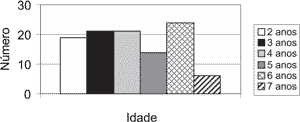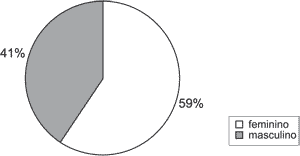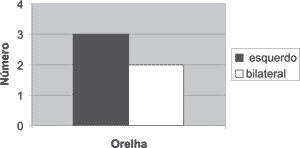| 3050 - Vol. 70 /
Ed 3 /
in 2004 |
|
 |
| Section: Artigo Original |
Pages: 380 to 384 |
|
|
|
| Otoacoustic emissions by distortion products in children aged 2 to 7 years |
|
| Authors: |
Alfredo R. Dell'Aringa 1,
Ana Helena Bannwart Dell'Aringa 2,
Antônio J. C. Juares 3,
Cinthia de Melo 4,
Renato M. Perches Filho 5 |
|
|
|
Keywords: otoaoustic emission, hearing loss, auditive screening.
|
|
Abstract: With the discovery of otoacustic emissions it has begun possible to analyze the auditive functions of external hair cells in the auditive cortex. The OAE can be spontaneous transients by distortions products. The DPOAE is an objective exam, fast, non painful, non invasive and easy to prescribe for screening in patients with hearing loss, and allow diagnoses and early rehabilitation. Study design: Transversal cohort. Material and Method: All children of Lar da Criança in Marília, SP, after previous authorization of the responsible, were submitted to on otorhinolaryngology exam and DPOAE. Results: The results presented that one hundred and five children participated in the study and 44,76% presented cerumen. Twelve children even after use of ceruminolytic and ear clearing persist with cerumen, or don't have parents or responsible permission. These children were exclude in the study. and 93 children were submitted to DPOAE After doing DPOAE in 93 patients, 5,37% were changed; 60% were male and 60% had bilateral changed. Discussion: The results were lower than the results find in literature, even the male predominance. Besides, we observe high prevalence of cerumen in our patients. Conclusion: Its essential an otorhinolaryngology evaluation before doing the DPOAE. It could be done in newborn, children and adults for early detection and prevention of failure in the cognitive and psycho-emotional development.
|
 |
INTRODUCTIONThe first reports of otoacoustic emissions were made by David Kemp, in 19781-3, which defined them as release of sound energy from the cochlea that propagates into the middle ear up to reaching the external auditory canal. After the studies by Békesy (1960)3 about the traveling wave, it was possible to understand the principle of sound collection that gets to the cochlea, is transformed into electrical energy and sent to cortex. It occurs as a result of the sinusoidal movement of the vibration of basilar membrane and Reissner's membrane when the inner ear is stimulated. The stimulation of sensorial cells occurs when there is greater vibration and amplitude of wave. Recent studies demonstrated the best functioning of Corti's organ, especially in outer hair cells. Therefore, traveling waves described by Békesy3 would be the first ones responsible for excitation of outer hair cells, which work as a real mechanical amplification system of up to 50dB intensity of stimuli from the cochlea 4. Otoacoustic emissions (OAEs) are under thresholds sounds generated by outer hair cells and require complete integrity of external and middle ear to be recorded. Any abnormality in transmission of acoustic stimulus can result in reduction or absence of response, hindering the analysis of the test. Bonfils et al. (1988)5 stated that OAEs do not quantify the hearing loss, but they detect its occurrence, since they are present whenever there is cochlear integrity, and they are not observed if auditory thresholds are above 30dB HL. As to the classification, acoustic otoacoustic emissions can be spontaneous, when recorded without presentation of sound stimulus. They are present in 30-60% of the ears with thresholds below 25-30dB 6-9, predominantly in women and neonates 10-13, and there is no significant dysfunction by age range 14. Evoked transient otoacoustic emissions require sound stimuli to be registered and the stimulus is normally used is a transient click of short duration with very comprehensive frequency range; and finally, distortion product, which requires a sound stimulus as defined by Kemp3 as "acoustic energy measured in the external auditory canal originating from the cochlea by non-linear interaction of two pure tones simultaneously applied". Distortion product otoacoustic emissions (DPOAE) occur when the ear is stimulated by two pure tones of different frequencies simultaneously, responding by intermodulation of two and generation of a third tone, of another frequency (Kemp 1979; Losbury-Martin, Harris, Stoney, Hawkins & Martin, 1990)15,16. These pure tones are called f1 and f2, being that f2 is the one of highest frequency. In human beings with normal hearing, the ratio between f1 and f2 is 1.22 and tends to provide the higher distortion product (Gaskill and Brown, 1990)16. The highest distortion product occurs in the frequency resulting from the equation 2f1-f2, being that f1
Studies and experiments have tried to compare the cochlear origin of evoked otoacoustic emissions (EOA) based on absence or reduction, by transient or permanent damage to outer hair cells such as those caused by ototoxic drugs, hypoxia and noise exposure, among others 6, 17, 18.
By means of cochlear analyzer, we can conduct DPOAE test in two ways. One of them is to provide a graph of input/output and another one is a DP-gram or audiocochleogram 3, 19, 20. The first one is graphic representation of the responses obtained with variation of intensity of stimuli in search for a threshold. The second one is the representation of many different frequencies by fixed intensities of L1 and L2.
Many studies examined the clinical utility of DPOAE 1, 2, 3, 16, 20, 21, such as hearing screening in newborn, support to hearing loss diagnosis, assessment of malingering patients, prognosis of endolymphatic hydropsis, follow-up of patients that use ototoxic drugs, prevention of noise-induced hearing loss, monitoring of inner ear during surgery.
This study intended to emphasize the use of DPOAE as hearing screening in children aged 2 to 7 years, to detect early hearing loss, allowing better social, psychoemotional and school development.
MATERIAL AND METHOD
The study comprised 105 children aged 2 to 7 years, enrolled at the nursery center "Lar das Crianças", located in Marília - SP, between June and December 2002. It included all children in kindergarten levels whose parents authorized the participation in the study. Four children did not participate in the study because the parents did not consent to it.
Initially, the children underwent complete ENT examination, with removal of cerumen, if possible, distortion product otoacoustic emissions (DPOAE) using de DP 2000, Starkey, in frequencies 2000, 3000 and 4000 Hz, with sound intensity of L1=65 dB SPL and L2=55 dB SPL. The response used for DP1 was = 2 f1 - f2 and DP2 = 2f2 - f120,21,22.
Both procedures were conducted at the nursery facility.
RESULTS
Out of 105 assessed children, 40 were aged 2 to 3 years, 35 were aged 4 to 5 years, and 30 were aged 6 to 7 years, as shown in Graph 1. The mean age was 3.85 years.
We can observe in Graph 2 that 59% of the children were female and 41% were male.
We found presence of cerumen in 44.76% (47 of the 105 studied children), being that in 13.33% (14) it was not possible to have it removed immediately by auricular lavage or mechanical extraction. Ninety-one children were submitted to hearing screening with DPOAE and two children after cerumen removal, totaling 93 children assessed by DPOAE.
We provided anti-cerumen drug to parents of 14 children that presented earwax of difficult removal in the first ENT examination, and they were instructed to use eardrops for one week and later come for cerumen removal. Out of the 14 children, 6 dropped out from school, 6 did not use the eardrops and 2 used the medication and earwax was removed and DPOAE were within the normal range.
Upon analyzing the results of DPOAE we detected that 5.37% of the assessed children had abnormal tests, being that 60% were male and 40% were female subjects (Graph 3). We also observed that one female child aged 5 years presented bilateral serous otitis media, being referred to specialized treatment.
As to affected ear, 60% of the children presented bilateral affection and 40% had unilateral loss, being that the left ear was more affected. We did not find any right ear unilateral affection (Graph 4).
 Graph 1: Age of 105 studied children. (GRAPH2)  Graph 2: Percentage of gender of 105 studied children.  Graph 3: Percentage of gender in 5 children with abnormal DPOAE.  Graph 4: Number of affected ears in 105 studied children.
DISCUSSION
The present study aimed at conducting hearing screening using distortion product otoacoustic emissions in a population without hearing complaints 23, 24.
In view of the results we obtained, we detected that 5.37% of the children presented abnormal DPOAE, which differs from the study by Vallejo (1999), in which 9.7% of the patients had abnormal transient otoacoustic emissions 25. We cannot assure that our results were inferior to those reported by the referred study because we used different types of otoacoustic emissions.
We also observed in our study greater occurrence of abnormal tests in male subjects, even in a predominantly female sample, which goes against the literature data that point the highest occurrence of abnormal OAE in female subjects 25.
During the conduction of ENT assessment, we detected that many children (44.76%) had earwax accumulation in the external ear canal. Upon comparing with the data available in the literature, we observed that they ranged from 6-15% 26-28.
All people responsible for the children were communicated about the results of the tests by letter. Those that presented abnormalities were referred to complete ENT examination. However, 20%, that is, one child only came to our service, and presented normal hearing, as reported by the parents. Out of the total, 40% did not come for specialized care and 40% dropped out from the nursery center. Thus, we observed difficulty to follow up these children that presented abnormal DPOAE. We considered that social-economic-cultural factors might have motivated the drop out rate.
CONCLUSION
Based on the analysis and discussion of results, we could conclude that otoacoustic emissions test proved to be useful to conduct hearing screening in children aged 2 to 7 years since it is of low cost, non-invasive, easy to perform and internationally accepted.
We also observed the importance of conducting otoscopy before DPOAE. We concluded that it is questionable to systematize it as the test for hearing screening programs if it is not preceded by ENT examination.
ACKNOWLEDGMENT
We would like to thank the collaboration to this study of Dr José Carlos Nardi - Master degree, Professor of the Discipline of Otorhinolaryngology; Dr Kazue Kobari - Physician, Professor of the Discipline of Otorhinolaryngology; Dr Fabiana E. Vasconcelos - Former intern of the Discipline of Otorhinolaryngology; Dr Sandra Fumi Uema - Former Resident of the Discipline of Otorhinolaryngology; Juliana Betine dos Santos - Speech Therapist and Audiologist of APAE, Marília.
REFERENCES
1. Oliveira JAA et al. Emissões otoacústicas no diagnóstico precoce de lesão coclear na Doença de Ménière. Rev Bras Otorrinolaringol 2002 set/out; 68(5): 761-6.
2. Costa Filho OA et al. Emissões otoacústicas evocadas - produto de distorção em neonatos audiologicamente normais. Rev Bras Otorrinolaringol 2001 set/out; 67(5): 644-8.
3. Lopes Filho O, Carlos RC. Emissões otoacústicas In: Da Costa HOO, Campos CAH. Tratado de Otorrinolaringologia. 1ª ed. São Paulo: Roca; 2003 v. 1. p.500-8.
4. Oliveira JAA. Fisiologia Clínica da Audição - Cóclea Ativa. In: Lopes Filho O, Campos CAH. Tratado de Otorrinolaringologia. São Paulo: Roca; 1995. p.510-30.
5. Bonfils P, Uzel A, Pujol R. Screening for auditory dysfunction in infants by evoked otoacoustic emissions. Archives of Otolaryngology Head and Neck Surgery 1988 August; 114(8): 887-90.
6. Mcfadden D, Plattsmier HS. Aspirin abolishes spontaneous otoacoustic emissions. J Acoust Soc Am 1984; 76:443-8.
7. Bonfils P. Spontaneous Otoacoustic emissions clinical interest. Laryngoscope 1989; 99: 752-6.
8. Lopes Filho O, Carlos RC. Produtos de distorções das emissões otoacústicas. Rev Bras Med Otorrinolaringol 1996; 3(5): 224-37.
9. Lopes Filho O. et al Emissões otoacústicas produtos de distorção na hidropsia endolinfática aguda. Caderno Otorrinolaringol. A Folha Médica 1996; 112 (supl.1): 87.
10. Probst R. et al. Spontaneous click and tone-burst-evoked otoacoustic emissions from normal ear. Hearing Research 1986; 21: 261-75.
11. Strickland AE, Burns FM, Tubis A. Incidence of spontaneous otoacoustic emissions in neonates under intensive care. Br J Audiol 1990; 24(5): 293-300.
12. Turek PM. Spontaneous narrow band acoustic signals emitted by human ears. J Acoust Soc Am 1981; 69: 514-23.
13. Bonfils P, Uziel A, Narcy P. The properties of spontaneous and evoked acoustic emissions in neonates and children: A preliminary report. Archives otolaryngology 1989; 246: 249-51.
14. Lonsbury-Martin BL, Cutler WM, Martin GK. Evidence for the influence of aging on distortion-product otoacoustic emissions in humans. J Acoust Soc Am 1991; 89(4):1749-59.
15. Munhoz MSL et al. Otoneurologia: Abordagem diagnóstica. In: Cruz OLM, da Costa SS. Otologia Clínica e Cirúrgica. 1ª ed. Rio de Janeiro: Revinter; 2000. p. 445- 62.
16. Gorga MP et al. From laboratory to clinic: a large-scale study of distortion product otoacoustic emissions in ears with normal hearing and ears with hearing loss. Ear & Hearing 1997 dec; 18(2):450-5.
17. Longsbury-Martin BL, Martin GK, Probst K. Acoustic distortion products in rabbit ear canal. Basic Features Physiological Vulnerability Hear Res 1987; 28: 173-89.
18. Turek PM, Clrck WM, Kim DO. The behavior of acoustic distortion products in the ear canals of chinchillas with normal or damaged ear. J Acoustic Soc Am 72: 774-80.
19. Gorga MP et al. The use of cumulative distributions to determine critical values and levels of confidence for clinical distortion product otoacoustic emission measurements. J Acoust Soc Am 1996 aug; 100(2): 968-77.
20. Gorga MP et al. Otoacoustic emissions from normal-hearing and hearing-impaired subjects: distortion product responses. J Acoust Soc Am 1993; 93 (4): 2050-61.
21. Gorga MP et al. Toward optimizing the clinical utility of distortion product otoacoustic emission measurements. J Acoust Soc Am 1996 aug; 100(2): 956-67.
22. Gorga MP et al. Predicting audiometric status from distortion product otoacoustic emission using multivariate analyses. Ear & Hearing 1999 apr; 20(2): 149-63.
23. Tiradentes JB, Coube CZV, Costa Filho OA. Estudo do padrão de respostas das curvas de crescimento (DP growth rate) das emissões otoacústicas produto de distorção em indivíduos com audição normal. Rev Bras Otorrinolaringol jan/fev 2002; 68(1): 21-6.
24. Wang YF, Wang SS, Tai CC, Lin LC, Shiao AS. Hearing screening with portable screening pure-tone audiometer and distortion product otoacoustic emission. Zonghua Yi Xue Za Zhi 2002 jun; 65(6): 285-92. Taipei.
25. Vallejo JC et al. Análise das emissões otoacústicas transientes em crianças com e sem risco auditivo. Rev Bras Otorrinolaringol 1999; 65(4): 332-6.
26. Minja BM, Machemba A. Prevalence of otitis media hearing impairment and cerumen impaction among school children in rural and urban Dar es Salaam Tanzania. Int J Pediatr Otorhinolaringol 1996 set; 37(1): 29-34.
27. Nazar J, Aguila P, Miranda E. El enigma del cerumen. Rev Otorrinolaringol Cir Cabeza Cuello 47(3): 91-9.
28. Sperling N et al. Doenças da orelha externa. In: Cruz OLM, da Costa SS. Otologia Clínica e Cirúrgica. 1ª ed. Rio de Janeiro: Revinter; 2000. p.121-36.
1 Ph.D., Head of the Discipline of Otorhinolaryngology, Medical School, Marília.
2 Speech Therapist and Audiologist, Specialization under course, Hospital de Reabilitação de Anomalias Crânio Faciais - USP - Bauru.
3 Resident Physician in Otorhinolaryngology, Medical School, Marília.
4 Resident Physician in Otorhinolaryngology, Medical School, Marília.
5 Resident Physician in Otorhinolaryngology, Medical School, Marília.
Address correspondence to: Disciplina de Otorrinolaringologia - Faculdade de Medicina de Marília - Av. Monte Carmelo 800 Fragata, Marília SP 17519-030.
Tel (55 14) 421- 1744 - E-mail: orl@famema.br - Ambulatório Mário Covas
|
Indexations: MEDLINE, Exerpta Medica, Lilacs (Index Medicus Latinoamericano), SciELO (Scientific Electronic Library Online)
CAPES: Qualis Nacional A, Qualis Internacional C
|
|
 |
|

|


